Mandatory ABS for Two-Wheelers by 2026: A Game Changer for Safety or Entry-Level Demand?, ET Auto
The Ministry of Road Transport and Highways published draft amendments to the Central Motor Vehicle Rules (1989) on June 27, 2025, making anti-lock braking systems (ABS) mandatory for all two-wheelers irrespective of engine size.

The government's move to mandate anti-lock braking systems (ABS) in all new two-wheelers from January 1, 2026, is expected to significantly enhance road safety but could dampen recovery in the entry-level segment, according to a recent ICRA report.
The Ministry of Road Transport and Highways (MoRTH) published draft amendments to the Central Motor Vehicle Rules (1989) on June 27, 2025, making ABS mandatory for all two-wheelers irrespective of engine size. Currently, only models with engine capacity above 125 cc are fitted with ABS. In addition, two protective helmets must be provided with every new two-wheeler purchase, effective three months from the date of implementation.
While the safety benefits of ABS — which prevents wheel lock during sudden braking — are widely recognised, ICRA warns that the increased cost of compliance may drive up prices by three to five per cent for two-wheelers under 125 cc. This could further strain the entry-level segment, which has already seen sluggish recovery following Covid-19 disruptions, increased fuel prices, and multiple regulatory cost additions over the last five to six years.
"Affordability remains a key concern," ICRA noted, highlighting that vehicle prices have jumped nearly 45 to 50 per cent since FY2019 due to evolving safety and emissions norms, along with rising input costs. Despite a gradual market rebound, two-wheeler volumes are yet to reach their peak of 21.2 million units recorded in FY2019.
The ABS mandate is part of the government's broader push to reduce two-wheeler fatalities, which remain disproportionately high despite stable accident figures.









